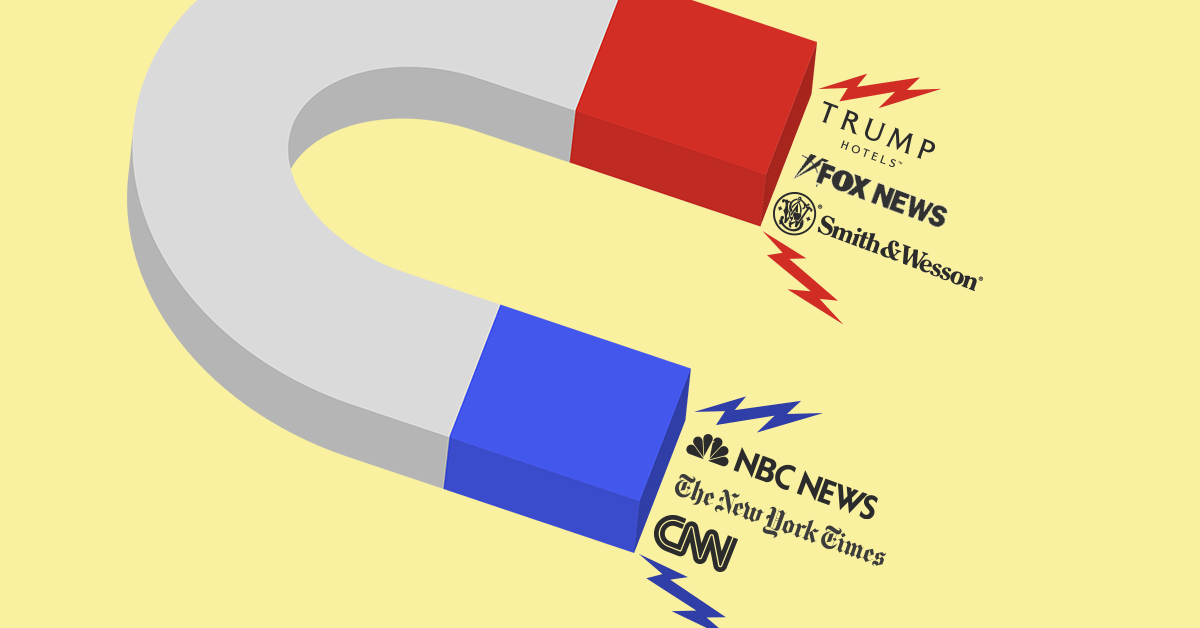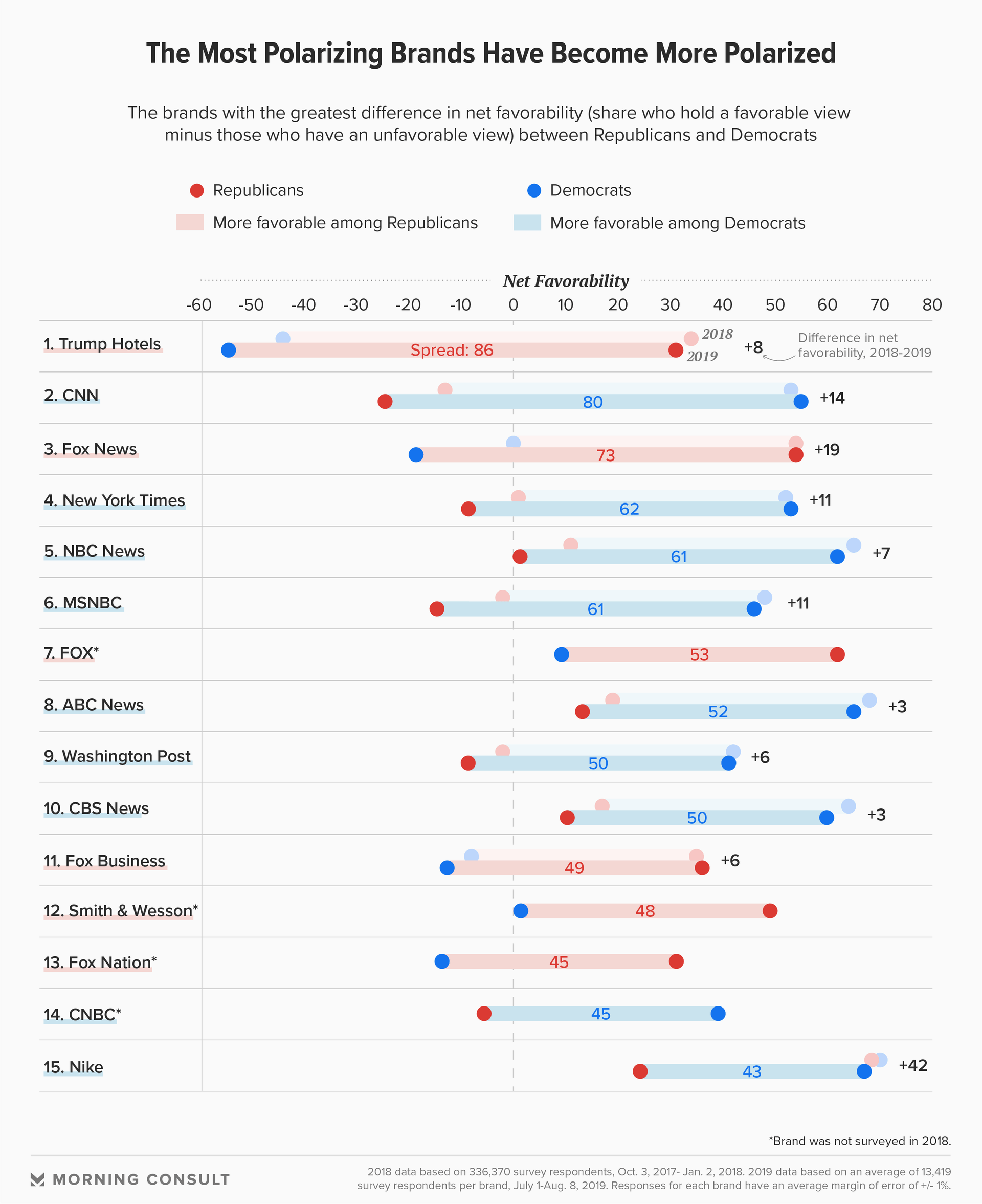Media Companies Dominate Most Divisive Brands List, and It Keeps Getting Worse

As President Donald Trump continues his relentless attacks on the mainstream media, the gap between how Republicans and Democrats view national media brands such as CNN and Fox News continues to widen, solidifying the country’s partisan echo chambers as the next presidential cycle nears.
News outlets make up 12 of the 15 most politically polarizing brands, out of the more than 3,700 brands that Morning Consult tracks daily, according to July 1-Aug. 8 polling that gauged an average of 13,419 survey respondents per brand.

This year’s findings are similar to 2018 data, but the political polarization has grown by double digits for some brands. Morning Consult determined the rankings by measuring the differences in net favorability — the share of U.S. adults with a favorable view of each brand minus those with an unfavorable view — among self-identified Democrats and Republicans.
“It is fair to say that the media reacted to Trump's election with alarm — and changed the tenor of its coverage in a way that that made the Democrats think the media is more important and made Republicans think it was more biased,” said Matt Grossman, an associate political science professor at the Michigan State University.
The difference between Republicans’ and Democrats’ net favorability for CNN, for example, stood at 66 percentage points last year. It grew 14 points to 80 this year, due to a 12-point drop in net favorability among Republicans, from minus 13 to minus 25. Republicans held more negative views than Democrats of every media outlet on the list except for Fox News.
“In a way, it's really corroboration of the narrative in the industry right now,” said Joe Barone, managing partner of Brand Safety Americas for GroupM, a media buying firm. “The narrative is that we're living in a polarized world, and media is both contributing to the polarization and reflective of the polarization.”
Steve Bannon, former White House chief strategist and Breitbart chairman, set the tone early in the Trump administration. “The media here is the opposition party,” he told the New York Times in a story published six days after Trump’s inauguration.
And for the major media outlets that have embraced a more adversarial stance on Trump since his election, business has been good.
Viewership for all three leading cable networks — CNN, Fox News and MSNBC — increased in 2018, per a Pew Research Center analysis of Comscore data.
For the three, total revenue and total profit both increased by 4 percent in 2018. The uptick in revenue was part of a 36 percent surge since 2015, from $3.87 billion to $5.26 billion. Profit, at $2.85 billion, was up 50 percent since 2015’s $1.9 billion.
The New York Times, the fourth most divisive brand on the list and a habitual punching bag for Trump, posted record print and digital subscriptions.
CNN, Fox News and MSNBC did not respond to requests for comment.
From an institutional perspective, experts said, the partisan polarization of news is a concerning phenomenon.
With local newspaper deserts growing, according to an analysis by the Columbia Journal Review, the public is becoming more reliant on national outlets. This, Grossman said, coincides with the politicization of the media — thanks, in large part, to Trump’s “fake news” rhetoric — and, to some extent, viewers moving toward more ideologically compatible outlets.
The polarization, Grossman noted, is far more pronounced on the right, and most prominent in Fox News' prime-time coverage.
Fox News stands out from every other media outlet on the list with its rosier perception among Republicans. Critics say that the network’s ideology, once firmly rooted in traditional conservative principles, has grown more flexible in the Trump era, reflecting positions that sometimes stray from GOP orthodoxy.
Grossman said the current climate gives the media two options: They can embrace a role as an ideologically defined media outlet, or try to remain nonpartisan — a stance that’s more difficult to take, especially in the eyes of conservatives.
Republicans have long held more suspicious views of the media, but Gallup shows it peaked in 2017 with a 58-point gap between the groups: Seventy-two percent of Democrats said they trusted mass media at least a fair amount, compared to 14 percent of Republicans. This year’s data shows slightly improved numbers, closing the gap to 54 points.
Perceptions of media credibility have dropped since 2016, according to Morning Consult analysis, largely fueled by Republican attitudes. Democrats and Republicans also tend to trust headlines from outlets that society considers closer to their ideology, although that changes by topic.
As these echo chambers grow, there is little room left for a single set of facts.
“We seem to be missing an independent objective news source that people can agree on,” said Barone. While it’s pretty hard to believe the polarization could continue to grow, he added, it’s difficult to see how the trend can be reversed.
Joanna Piacenza leads Industry Analysis at Morning Consult. Prior to joining Morning Consult, she was an editor at the Public Religion Research Institute, conducting research at the intersection of religion, culture and public policy. Joanna graduated from the University of Wisconsin-Madison with a bachelor’s degree in journalism and mass communications and holds a master’s degree in religious studies from the University of Colorado Boulder. For speaking opportunities and booking requests, please email [email protected].
Related content

As Yoon Visits White House, Public Opinion Headwinds Are Swirling at Home

The Salience of Abortion Rights, Which Helped Democrats Mightily in 2022, Has Started to Fade
